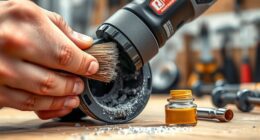To stabilize wobbly furniture safely, start by inspecting the joints for damage or looseness. Reinforce weak spots with suitable materials like wood glue, metal brackets, or corner blocks to distribute weight evenly and strengthen connections. Matching reinforcement materials with your furniture guarantees durability. Using proper fasteners and adhesives will create long-lasting stability. If you’re interested in more expert tips, you’ll find effective techniques and materials that help restore your furniture’s strength and safety.
Key Takeaways
- Identify and reinforce weak joints using appropriate materials like wood glue, brackets, or fasteners to enhance stability.
- Select materials that match the furniture’s original components for seamless, durable repairs.
- Use specialized techniques such as adding corner blocks or metal braces for stronger joint reinforcement.
- Ensure proper weight distribution and balance to prevent further wobbling or structural stress.
- Regularly inspect and maintain furniture to reinforce joints and prevent future instability.

Have you ever wondered why structural repairs are vital for maintaining the safety and integrity of a building? When it comes to fixing wobbly furniture, the same principles apply, just on a smaller scale. Ensuring stability isn’t just about gluing a leg back onto a chair; it involves understanding how different parts of the furniture work together and making strategic repairs to reinforce weak spots. One of the key elements in this process is joint reinforcement. Joints are the weakest points in most furniture pieces, especially in chairs, tables, or cabinets that have seen years of use. Reinforcing these joints prevents further deterioration and guarantees the piece remains safe and functional. Whether you’re using wood glue, metal brackets, or specialized fasteners, strengthening the joints helps distribute weight more evenly and reduces stress on vulnerable areas. Additionally, choosing the right adhesive or fastener ensures a more reliable and lasting repair.
Reinforcing furniture joints ensures stability, safety, and longevity of your repair efforts.
Material selection plays an essential role in stabilizing wobbly furniture. You need to choose the right materials that match or complement the existing structure to guarantee durability and effectiveness. For example, if you’re repairing a wooden chair, using the same type of wood or a compatible hardwood for reinforcement will create a seamless, strong bond. If the original material is brittle or damaged, you might consider more resilient options like epoxy resins or high-quality wood fillers. Selecting appropriate materials isn’t just about strength; it’s also about compatibility. Incompatible materials can cause further damage over time due to differences in expansion, contraction, or chemical reactions. Proper material selection guarantees that your repair lasts longer and maintains the aesthetic appeal of the furniture.
When reinforcing joints, consider the type of joint and the best method to reinforce it. For example, a mortise and tenon joint might benefit from additional dowels or braces, while a butt joint could be strengthened with corner blocks or metal brackets. The goal is to create a stable, sturdy connection that can withstand regular use. Besides reinforcement techniques, pay attention to the quality of the materials used—using low-quality fasteners or adhesives might save money initially but could lead to future failures. Investing in high-quality, appropriate materials and reinforcing joints properly can mean the difference between a temporary fix and a lasting repair. Understanding toilet types and features can be a helpful analogy, emphasizing the importance of selecting the right components for durability and performance.
Ultimately, stabilizing wobbly furniture requires a thoughtful approach. Reinforcing joints and carefully selecting materials are foundational steps that guarantee your repairs are both effective and durable. You’ll restore not just the look but also the safety and functionality of your furniture, giving it a new lease on life. So, next time your favorite chair wobbles, remember that with the right joint reinforcement and material choices, you can fix it securely and confidently.
Frequently Asked Questions
Can I Repair Wobbling Furniture Myself Without Experience?
Yes, you can repair wobbling furniture yourself with some DIY tips and careful attention to detail. Start by inspecting the joints and tightening loose screws or bolts. Use wood glue or epoxy to fix cracks or loose parts, and consider adding corner braces for extra stability. With patience and basic tools, you can successfully restore your furniture’s stability. Just remember to follow safety guidelines and take your time to ensure a quality furniture restoration.
What Tools Are Necessary for Stabilizing Wobbly Furniture?
Think of fixing wobbly furniture as taming a wild beast—you need the right tools to succeed. Grab a screwdriver, hammer, wood glue, clamps, and a level to get started. Don’t forget safety gear like gloves and goggles to protect yourself from splinters and mishaps. An overview of these tools helps you work confidently, ensuring your furniture stands steady, like a proud monument, after your careful repairs.
How Long Do Structural Repairs Typically Take?
The repair duration for stabilizing wobbly furniture varies based on the extent of the damage and your skill level. Generally, it takes a few hours to complete, but timing considerations like drying time for adhesives or paints can extend this. If you’re experienced, you might finish faster, but always permit enough time for proper curing to ensure long-lasting results. Plan your project accordingly for the best outcome.
Are There Safety Precautions for DIY Furniture Repairs?
Yes, there are safety precautions you should follow during DIY furniture repairs. Always wear safety gear like gloves and goggles to protect yourself from splinters or debris. Be aware of hazards like loose parts or unstable furniture, and make certain your workspace is clear and well-lit. Take your time, follow instructions carefully, and stay alert to avoid accidents. Safety should always come first to make sure you repair your furniture safely.
When Should I Replace Rather Than Repair Wobbly Furniture?
You should replace wobbly furniture when repairs, like wooden joint repair and furniture reinforcement techniques, become too costly or ineffective. If multiple joints are damaged or the piece’s stability is compromised despite reinforcement, it’s safer to invest in new furniture. Consider replacing if the repair risks compromising safety or if the furniture no longer meets your needs, ensuring you avoid ongoing issues and potential accidents.
Conclusion
Now that you know how to stabilize wobbly furniture safely, you’ll find yourself more confident tackling repairs. It’s funny how a simple fix can restore not just your furniture but also your peace of mind. As you tighten, reinforce, and stabilize, you’ll realize that preventing future wobbliness becomes second nature. So, next time your furniture starts to wobble, remember these steps—because sometimes, the smallest fixes make the biggest difference, and you’re already halfway there.









